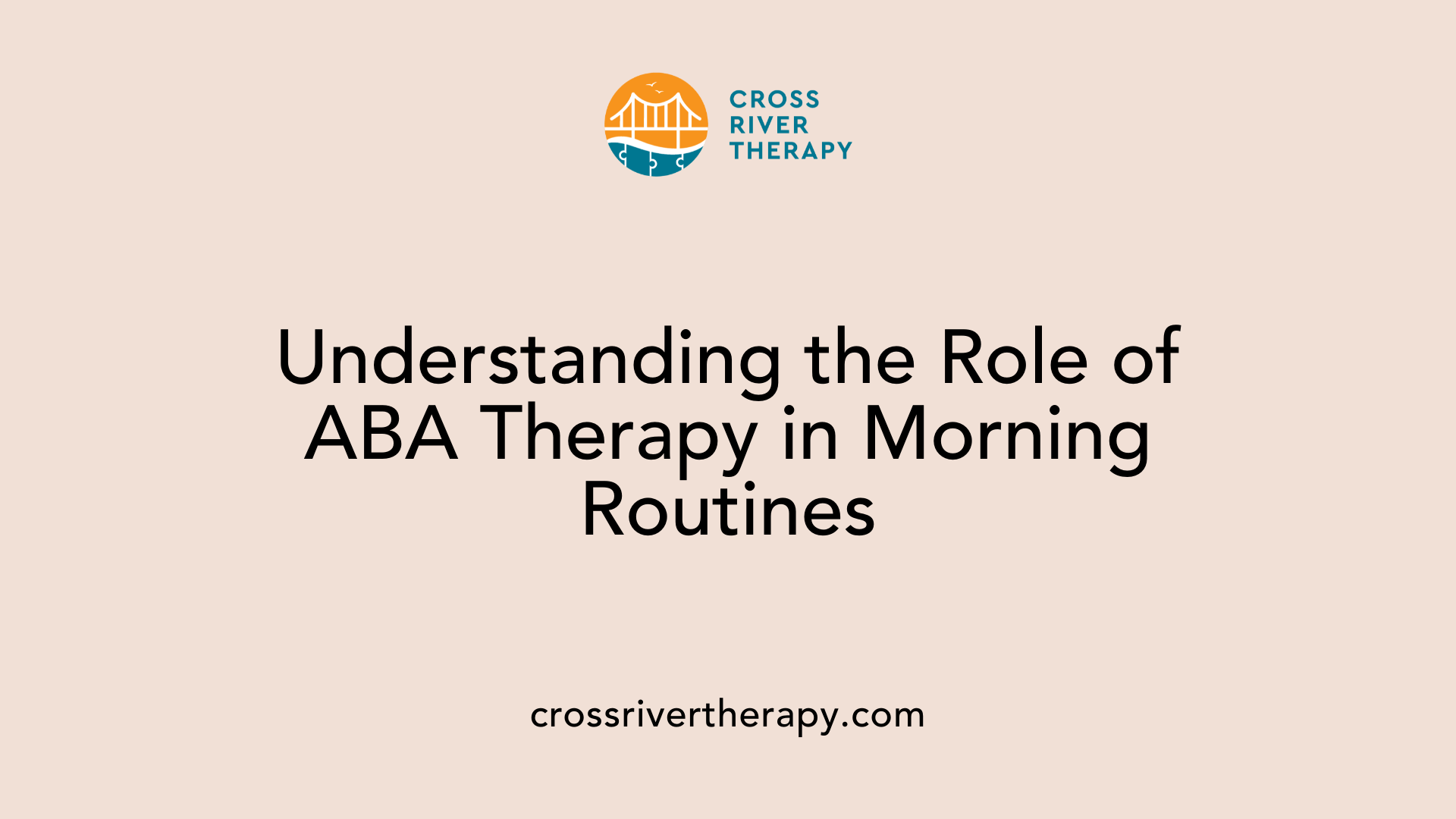How ABA Therapy Helps Develop Positive Morning Routines
Unveiling ABA Therapy's Role in Shaping Effective Morning Habits
Introduction
Morning routines can be particularly challenging for children with autism and their families. Establishing a structured and positive start to the day is not only beneficial for the child's wellbeing but also sets the tone for the day ahead. Applied Behavior Analysis (ABA) therapy has long been recognized for its success in aiding behavioral development in individuals with autism. In this article, we explore how ABA therapy can effectively assist in developing positive morning routines, promoting independence, and fostering confidence in children with autism.
Breaking Down Morning Routines Using ABA Therapy

How does ABA therapy teach life skills?
ABA therapy uses a personalized approach tailored to each individual's unique needs and abilities. This is particularly important for children with autism as it leverages their strengths and addresses their challenges.
Creating effective morning routines is essential for children with autism, and ABA therapy plays a vital role in this process. By breaking down complex tasks into smaller, manageable steps, children can follow routines with greater ease. This method, known as task analysis, simplifies routines like getting dressed or brushing teeth, making each step clear and less overwhelming.
Structured support in ABA focuses on consistency and predictability, both of which are crucial for children with autism. Visual schedules detailing daily tasks help these children anticipate what comes next, reducing anxiety during transitions. By integrating visual aids with positive reinforcement—such as praise or rewards—children are motivated to engage fully in their morning routines.
Additionally, establishing consistent morning rituals enhances independence. Children learn to manage their responsibilities through repeated practice and structured guidance, ultimately navigating their day with increased confidence.
The Power of Positive Reinforcement in Morning Success

What is positive reinforcement in ABA therapy?
Positive reinforcement in ABA therapy is a technique that enhances learning by rewarding desired behaviors. When a child completes a task successfully, they receive a reinforcing stimulus, such as praise or a tangible reward. This approach significantly increases the likelihood that the child will repeat the desired behavior in the future.
Positive reinforcement techniques
To effectively implement positive reinforcement during morning routines, consider the following strategies:
- Verbal Praise: Specific acknowledgment of what the child did well encourages repetition. For example, saying, "Great job brushing your teeth without reminders!"
- Tangible Rewards: Items like stickers or small toys can motivate children to engage positively with their routines.
- Visual Progress Tracking: Systems like token economies help children visualize their achievements, instilling a sense of accomplishment as they earn tokens towards a goal.
- Immediate Reinforcement: Offer rewards right after the desired behavior to create a strong link between the action and the reward.
Motivating children to complete tasks
Incorporating these techniques into morning routines not only boosts motivation but also cultivates confidence. Children are more likely to engage in daily tasks when they foresee a reward.
For example, when preparing for school, setting a timer for each activity encourages timely transitions and promotes task completion. This structured environment, coupled with consistent reinforcement, fosters a sense of security and predictability, further alleviating morning anxiety.
By tailoring rewards to align with a child’s preferences, parents can effectively engage their child, making morning routines smoother and enhancing overall independence.
Utilizing Visual Schedules for Better Understanding and Independence

Using Visual Aids in ABA
Visual aids play a critical role in ABA therapy, especially for children with autism. These aids can include pictures, drawings, or lists that outline specific activities. By providing these visual supports, children can more easily grasp the tasks they need to complete in their daily routines. This concrete representation allows for a clearer understanding of expectations, decreasing confusion and anxiety around transitions.
Supporting Transitions with Visual Schedules
Transitions can often pose challenges, but visual schedules help address these difficulties effectively. By creating a morning routine visual schedule, parents and therapists can help children anticipate changes. For instance, including images for each morning task—such as getting dressed, brushing teeth, and preparing breakfast—can facilitate smoother transitions. This strategies not only reinforce the routine but also promote independence, as children learn to navigate their mornings with greater confidence and ease.
| Visual Support Type | Purpose | Benefits |
|---|---|---|
| Picture Schedules | Outline tasks for routines | Reduces anxiety and promotes independence |
| Step-by-step Lists | Break down complex tasks | Supports understanding of sequential activities |
| Timers | Indicate transitions | Encourages timely completion of tasks |
Incorporating such visual tools can empower children with autism to follow routines more effectively, paving the way for increased independence at home and beyond.
Consistency: The Cornerstone of Effective Morning Routines

Importance of Routine Consistency
Establishing consistent morning routines is essential for children with autism. Consistency provides predictability, helping children anticipate what comes next. This predictability can significantly reduce anxiety, particularly during mornings, which can often be challenging. Children who understand their routines are more likely to approach their day with confidence and less stress.
Every predictable element—whether it’s a regular wake-up time or a series of morning tasks—creates a sense of security. This structure allows children to feel in control and comfortable, paving the way for smoother transitions into the day.
Reducing Anxiety Through Predictability
Implementing structured routines, such as preparing for school or managing morning tasks, reduces uncertainty. By using visual schedules, children can follow daily activities easily. Visual aids can reinforce what is expected and help clarify the sequence of tasks.
Moreover, setting timers for each activity can help children understand time management and transitions. Reinforcing timely task completion through positive rewards can motivate them to stick to their routines. This not only fosters independence but also builds invaluable self-management skills.
The Systematic Approach of ABA in Fostering Independence

Generalization of Skills
ABA therapy is particularly effective in teaching children with autism to generalize skills learned in structured sessions to various environments. This means that tasks, such as self-care or social interactions, can be consistently applied in different settings like home or school.
By introducing skills within familiar contexts and gradually helping children to adapt these practices to new situations, ABA makes routines not just a set of tasks, but part of everyday life. This approach empowers children to navigate different routines, boosting their confidence and independence.
Developing Confidence Through ABA
Confidence in daily activities is a significant focus of ABA therapy. Through structured methods like task analysis, children learn to break tasks into smaller, manageable steps, which prevents feelings of overwhelm. For example, a morning routine can start with simply getting dressed, gradually incorporating other activities.
Positive reinforcement plays a pivotal role here. By rewarding children for successfully completing tasks or following routines, they become more motivated to engage. Techniques like using visual schedules and praise not only simplify the process but also enhance their self-esteem. Children start to associate routine completion with success, fostering a sense of achievement.
Incorporating these practices into everyday activities helps cultivate independence, allowing children to manage their mornings with confidence and ease.
How Can ABA Therapy Be Applied in Everyday Life?
ABA therapy can be applied in everyday life in numerous ways beyond structured therapy sessions. For example, caregivers can use positive reinforcement to encourage desired behaviors during playtime, such as taking turns or using words to express feelings. Communication skills can be enhanced by modeling language in daily conversations and using visual aids to support understanding. Establishing a consistent daily routine can help individuals feel more secure and understand expected behaviors. Teaching children to identify animals, colors, and shapes can foster learning in a fun, engaging manner. Furthermore, incorporating ABA principles in social settings can improve interactions with peers and promote important life skills.
Overcoming Morning Challenges with ABA Strategies
What benefits does ABA therapy provide?
ABA therapy offers numerous benefits, particularly for individuals on the autism spectrum. It promotes language and communication skills, enhances attention, focus, and social skills, and aims to decrease problem behaviors through positive reinforcement techniques. Customized by a board-certified behavior analyst (BCBA), ABA therapy is tailored to meet the unique needs of each individual, making it effective across various ages and levels of severity. Research shows that early intervention with ABA leads to better long-term outcomes, though adolescents and adults can also benefit from its application. Overall, ABA is recognized as an evidence-based best practice treatment endorsed by leading health organizations for improving the lives of individuals with autism.
Handling transitions smoothly
Transitions can be particularly challenging for children with autism. ABA therapy addresses this by implementing structured routines and visual schedules. These tools help children anticipate and navigate morning activities with greater ease.
Routines create predictability, reducing anxiety and allowing children to feel in control. Key aspects of this include using visual supports like images or lists outlining each task, setting timers to signal transitions, and incorporating reinforcements for completing tasks successfully.
Preparing in advance
To prepare for the day ahead, parents can establish a consistent bedtime and wake-up routine. Additionally, organizing items needed in the morning—such as selecting clothes or packing lunches the night before—can significantly reduce morning stress. By planning ahead, families can avoid potential meltdowns and create a smoother flow to the morning routine, supporting a calming start to the day.
Conclusion
ABA therapy provides a systematic approach to developing effective and positive morning routines for children with autism. By implementing strategies such as task analysis, positive reinforcement, visual schedules, and consistency, parents and caregivers can help children navigate the start of their day with greater ease and confidence. This not only supports the child's independence but also reduces anxiety and contributes to a harmonious household. As with many aspects of ABA, individualization is crucial – tailoring strategies to fit the unique needs of each child ensures the greatest success in fostering productive and enjoyable mornings.
References
- How ABA Therapy Helps with Daily Routines
- How ABA Therapy Builds Consistency for Lasting Success
- How To Simplify Your Morning Routine - The Behavior Place
- How ABA Therapy Build Independences in Daily Routines
- Morning Routines - Cayman ABA
- The Benefits of Forward Chaining in ABA Therapy
- 5 Ways To Use Positive Reinforcement In ABA Therapy - Forta Health



